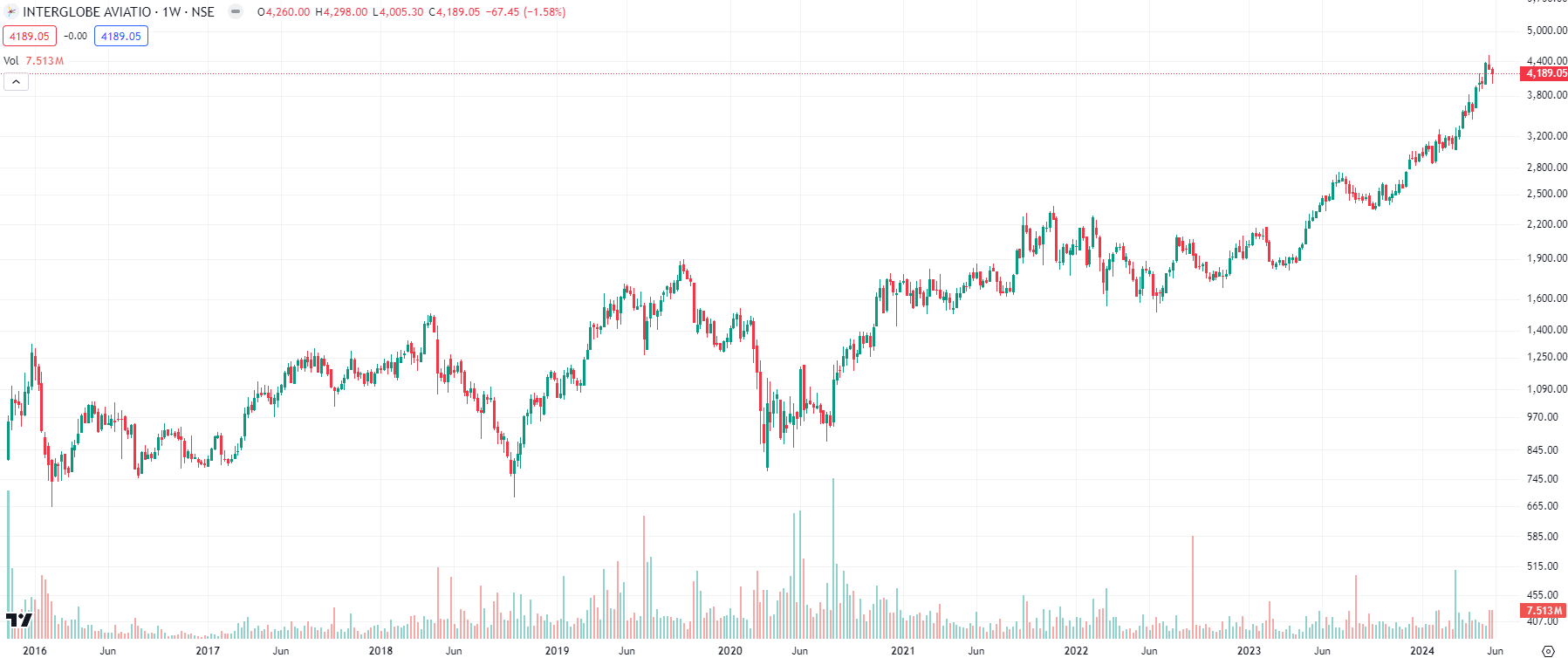Indigo (NSE:INDIGO): Why India’s largest airline is a good opportunity to look at
![]() Nick Sundich, June 7, 2024
Nick Sundich, June 7, 2024
20 years ago, Indigo (NSE:INDIGO), also known as InterGlobe Aviation, didn’t even exist. But now, it is the best example of an airline you could use to debate Richard Branson’s assertion that the best way to become a millionaire is to be a billionaire and start an airline.

Indigo (NSE:INDIGO) share price chart, log scale (Source: TradingView)
Introduction to Indigo
Indigo is India’s largest airline, not just low-cost, but largest airline overall, with a market share of over 60%. 1,800+ flights are run daily, across 78 domestic destinations and 26 international destinations. It is headquartered in Gurgaon (a satellite city on the south-west corner of Delhi), but has hubs all across the country. The company was founded by Rakesh Gangwal in 2006, who still owns over 25% of the airline, and listed in 2015. The carrier has over 300 narrow-body aircraft in the Airbus A320 family (A320ceo, A320neos and A321neos) as well as 45 ATR turboprops and a handful of A321 freighters.
Indigo reported its profit for the 12 months to March 31, 2024 and it made 71,200 crore (or 712bn rupees which is A$41.1bn) in revenue and a profit of 8,200 crore (or 82bn rupees which is $1.48bn), representing a margin of 11.5%. For comparison’s sake Qantas has had a margin of 7.5% in the last 12 months. And the IATA expects airlines’ net profit margins to be…2.7% in CY24.
Why it is profitable? It’s an airline after all…
Putting to one side the fact that Indigo is an Indian airline. It is a low-cost carrier and can make higher margins because of the money it can make via add-ons to the ticket such as baggage fees and food. Legacy carriers have higher prices, with all the ‘frills’ included, but there is a significant proportion of the market that will pay a lower price to get from A to B. They may be stung by surprise fees and complain on social media, but will book that airline again when they find it is 1-2% cheaper than the competition.
But another thing low-cost carriers have in common is that rather than having a hub-and-spoke model, low-cost carriers go point to point. Case in point: American Airlines has nearly a dozen hubs, but its biggest is in Dallas Fort Worth. Virtually all of its flights are to or from one of its hubs. So if you want to go San Francisco to Baltimore with American Airlines, for instance, you can’t fly non-stop, you have to transit through a hub like Dallas. Alternatively, fly an airline with a hub in San Francisco (like United) to get form A to B.
Low-cost carriers do have some ‘bases’ where they position aircraft and conduct maintenance, but they offer point to point flights that legacy carriers with a hub and spoke model do not. These budget conscious consumers would rather pay less to go direct than pay more to go indirect. This is the market Indigo is targeting.
The opportunity is massive
Now let’s look at the market opportunity before Indigo. The Indian economy is going to keep growing, set to be the 3rd largest by 2027. The country has 18% of the world’s population and has a median population age of 27. By 2030, 300 million will be middle income and 29 million will be higher income – up from 18m and 8m respectively in 2018.
Indian passenger numbers are estimated to be 225m this year, but to grow to 510m by 2030 (more than double in 6 years). Yet, there were 6.2bn railway passengers and just 6.5% of Indians hold valid passports. You can imagine there’s a big opportunity if the population’s income increases, develop a desire for travel, and seek a more convenient way.
Big expansion underway
The entire Indian industry is forecasting this dream to come to reality. The government is investing in airport infrastructure like crazy, setting a target in 2023 to grow from 148 airports to 220 by…2025. Over 30% of new aircraft orders in 2023 came from Indian carriers, 1,124 from India and 2,426 from the rest of the world. Of India’s 1,124 orders, 500 came from Indigo, more than any other carrier. This was a single order made at the 2023 Paris Airshow that was the largest-ever single aircraft purchase by any airline with Airbus. It was an order for Airbus A320 Family (although the exact mix of aircraft is yet to be determined, meaning how many A321s or A320s). This takes the formal order-book into the next decade of over 1,000. Its order book includes the renowned A321XLR. Deliveries will begin from 2025 and Indigo has largest order of any airline for this type.
Only a few weeks ago (in May 2024), Indigo also ordered the Airbus A350-900, 30 firm orders with 70 options, deliveries from 2027. The company has aspirations to serve medium and long-haul international markets and this will make it possible. It does already serve some ‘closer’ markets from India like Sri Lanka, the UAE and Singapore, but this will enable it to serve markets like Australia and Europe.
A good ESG angle
If you’re an ESG investor, you may like companies with a high proportion of female management or staff. Indigo exclusively employs female cabin crew, has 44% of its office staff female and employs the highest number of female pilots around the world (680 as of October 2022). Granted, it only has one woman on its board.
On the environmental aspect of ESG, the company has cut its carbon emissions by 20%, and this figure is expected to improve as the fleet becomes more modern. In 2017, only 15% of its fleet was the next generation neo (new engine option) aircraft, but this is now 80%. It has also eliminated Single Use Plastic items with biodegradable options.
A great opportunity
Investing in India is easier said than done if you are in Australia. But if you want to take the plunge and invest in Indian stocks directly, Indigo is the stereotypical company that could profit from the continued enriching of the Indian population and infrastructure investment. A stock that is already a large player in the market, in a market that is set to grow substantially in the future and would be difficult for newcomers to penetrate.
What are the Best ASX Stocks to invest in right now?
Check our buy/sell tips
Blog Categories
Get Our Top 5 ASX Stocks for FY26
Recent Posts
Larvotto Resources is fully funded for its $694M Hillgrove Project
18% Jump for Larvotto Resources as Hillgrove Construction Moves Ahead, Backed by $175M in New Funding Larvotto Resources (ASX: LRV)…
Archer Materials Cracks Quantum Readout Challenge as Stock Surges 12%
Archer Materials Just Solved One of Quantum Computing’s Hardest Problems Archer Materials (ASX: AXE) jumped 12% today after unveiling two…
NVIDIA’s Blackwell Chips Ignite Record Demand in Q3
NVIDIA’s Blackwell Surge Tech investors and growth-focused funds will be breathing a sigh of relief after NVIDIA (NASDAQ: NVDA) delivered…



